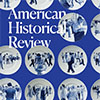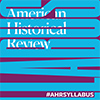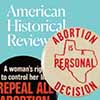The March issue opens the 129th volume of the American Historical Review with articles and forums that rethink approaches to intellectual, migration, imperial, Indigenous, and digital histories.
.png)
The March History Lab brings a new installment of Art as Historical Method that focuses on the place of history in art made by and about Indigenous peoples. The cover image is drawn from Cree artist Kent Monkman’s 2019 monumental painting mistikôsiwak (Wooden Boat People): Resurgence of the People, commissioned for the Metropolitan Museum of Art’s Great Hall. Monkman’s work explores issues of colonization, sexuality, and resilience to challenge received ideas about history and Indigenous peoples. Kent Monkman. Resurgence of the People, 2019. The Metropolitan Museum of Art, New York. Image courtesy of the artist.
Opening the March issue is Edward Muir’s (Northwestern Univ.) AHA presidential address, “Conversations with the Dead,” which emerges from his distinguished scholarship on Italian social and cultural history of the late Middle Ages and the Renaissance. The address self-consciously builds on the practices of Machiavelli and other Italian Renaissance thinkers who, Muir says, often talked with the dead. He writes that these “conversations with the dead imagine a give and take—questions from us, answers from them—pursued in an imaginative space, but one carefully controlled by the documents, until we, as Machiavelli wrote, become completely part of them.” In his address, Muir proposes “such an imaginative space begets a certain kind of historical method, a species of history that demands we ask the right questions of our dead interlocutors in the hopes of learning the right answers.” Muir tests this method by re-creating four conversations with people living in Italy from the 15th to the 17th century, among them two peasant families, an involuntary nun, and a friar who Muir says “became the most popular satirist of his age.”
In “Migrating Concepts: The Transnational Origins of the Bracero Program, 1919–42,” Julie Weise (Univ. of Oregon) and Christoph Rass (Osnabrueck Univ.) reexamine the genealogies of a program that recruited four million Mexican men to work in the United States during and after World War II. They argue the Bracero program’s foundational ideas emerged out of two decades of exchange and circulation during the interwar period in which Mexican politicians, intellectuals, and migrant labor activists eagerly participated in transatlantic and inter-American dialogues about migration policy and came to embrace a set of model bilateral labor migration agreements that had recently emerged in Europe. US officials resisted their pleas to emulate European practices, but when World War II pushed the United States toward securing a labor agreement with Mexico, Weise and Rass argue, it was Mexicans’ transatlantic knowledge that shaped crucial aspects of the program’s design.
Diana Kim’s (Georgetown Univ.) “‘Evil Spectators’: Opium and Empire’s Stakeholders in 20th-Century Southeast Asia” reconsiders the relationship between opium and empire. By centering attention on lesser-known pro-opium forces in Southeast Asia, she demonstrates how “bad” actors recognized now as apologists for a dangerous drug were once essential stakeholders in imperial rule. Kim focuses on banks, shipping companies, traders, and industries employing opium-smoking laborers that sustained the drug’s supply chains from India to British Malaya and French Indochina until the 1930s. She explores how these profit-seeking actors represented situational allies with linked fates despite diverse opinions, fragmented interests, and ambivalent positions toward their own opium-entangled practices. In doing so, Kim both demonstrates the centrality of Southeast Asia to histories of opium commerce (which previously have focused on China and India) and complicates the historical origins of global drug control.
“Such an imaginative space begets a certain kind of historical method, a species of history that demands we ask the right questions of our dead interlocutors.”
The AHR History Lab opens with a new installment of Art as Historical Method, “Contemporary Indigenous Art and History.” Brenda Child (Univ. of Minnesota) discusses her encounters with the work of three contemporary Sámi artists—Máret Ánne Sara, Anders Sunna, and Pauliina Feodoroff—whose work was featured at the 2022 Venice Biennale. She reflects on how their artistic practices are similar to her own as an Indigenous historian working in the United States. Patricia Marroquin Norby (Metropolitan Museum of Art) seeks to recover the submerged presence of Indigenous histories in art made by non-Indigenous artists, reexamining the work of Georgia O’Keeffe and highlighting the centrality of the artist’s 40-plus-year relationship with her Abiqueño, American Indian, and Hispano neighbors to O’Keeffe’s canonical southwestern skull-and-bone paintings. Matthew Martinez (Mesa Prieta Petroglyph Project) interviews Virgil Ortiz, a Cochiti Pueblo artist whose work combines pottery and an Indigenous futurist sensibility to re-create new histories of the 1680 Pueblo Revolt.
A symposium on the explosion of digitized historical newspapers and their uses is also part of the March Lab. In “Digitized Newspapers and the Hidden Transformation of History,” Heidi Tworek (Univ. of British Columbia) brings together historians, literature scholars, digital archivists, and scholars located in information schools to discuss their work with digitized newspapers from a variety of geographical spaces. Avery Blankenship (Northeastern Univ.), Ryan Cordell (Univ. of Illinois at Urbana-Champaign), Yushu Geng (NYU Shanghai), Rachel Leow (Univ. of Cambridge), Callie Wilkinson (Ludwig Maximilian Univ. of Munich), Zoe LeBlanc (Univ. of Illinois at Urbana-Champaign), Brewster Kahle (Internet Archive), and Lila Bailey (Internet Archive) offer a set of methodological and theoretical reflections on the larger meanings of these digital collections for contemporary historical practice.
The History Lab includes a new #AHRSyllabus module. Agnieszka Aya Marczyk (Yale Univ.), Abby Reisman (Univ. of Pennsylvania), and Brenda Santos’s (Brown Univ.) “Teaching Historiography: Testimony and the Study of the Holocaust” introduces a new curricular and instructional model, Historiography-Based Inquiry, that allows students to see the processes through which historians make claims and marshal evidence to support them. Their module also offers a lesson plan that allows teachers to take this new approach right into their classrooms, one centered on unpacking the role of survivor testimony and the voices of victims in the historiography of the Holocaust.
A History Unclassified essay closes out the March issue. In “Chilling Affects,” Woody Holton (Univ. of South Carolina) looks at ongoing controversies over teaching African American history through the lens of his own experiences as a classroom teacher and public debates in his home state of South Carolina. In his essay he explores the local dynamics of censorship and book banning as well as the campaigns of grassroots activists who have opposed those efforts.
Mark Philip Bradley is editor of the American Historical Review and the Bernadotte E. Schmitt Distinguished Service Professor of History at the University of Chicago.
Tags: AHA Activities American Historical Review Asia/Pacific Digital History Europe Latin America North America Cultural History Indigenous History Labor History Migration/Immigration/Diaspora Social History Teaching Resources and Strategies

This work is licensed under a Creative Commons Attribution-NonCommercial-NoDerivatives 4.0 International License. Attribution must provide author name, article title, Perspectives on History, date of publication, and a link to this page. This license applies only to the article, not to text or images used here by permission.
The American Historical Association welcomes comments in the discussion area below, at AHA Communities, and in letters to the editor. Please read our commenting and letters policy before submitting.
Comment
Please read our commenting and letters policy before submitting.










